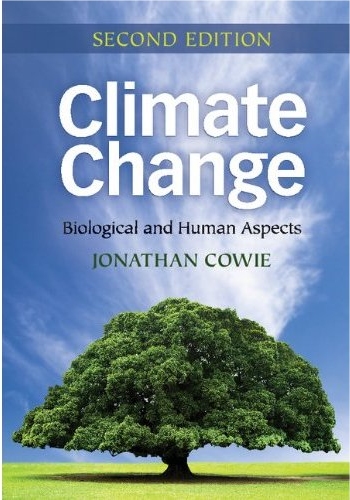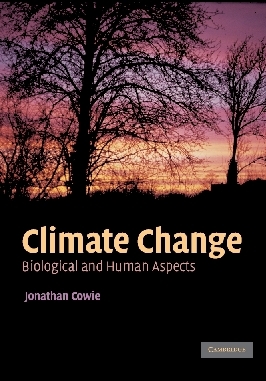Climate Change: Biological & Human Aspects
DOI:10.1017/CBO9780511803826
This line links to excerpts of the book’s first (2007) edition reviews.
This line links to excerpts of the book’s second (2013) edition reviews
This line links to the book’s Cambridge U. Press' promotional leaflet
(2013 2nd edition) Cambridge University Press, paperback, xxii + 558 pages
ISBN 978-1-107-60356-1. DOI:10.1017/CBO9781139087735
Lecturer resources for this book from Cambridge University Press
|
 2nd edition 2013 Revised (updated) and substantially expanded. (Almost 33% greater word count) |
-- 1st edition cover descriptor --
In recent years climate change has become recognised as the foremost environmental problem of the twenty-first century, and a subject of considerable debate. Not only will climate change affect the multi-billion dollar energy strategies of countries worldwide, but it could also seriously affect many species, including our own. Written in an accessible style, this textbook provides a broad review of past, present and likely future climate change from the viewpoints of biology, ecology and human ecology. It is thoroughly referenced, allowing readers, if they wish, to embark on their own more specialist studies.
A fascinating introduction to the biology and human ecology of climate change, this textbook will be of interest to a wide range of people, from students in the life sciences who need a brief overview of the basics of climate science, to atmospheric science, geography, geology and environmental science students who need to understand the biological and human ecological implications of climate change. It will be a valuable reference for those involved in environmental monitoring, conservation, policy-making and lobbying. It will also be of interest to those concerned with climate issues in the energy utilities.
Contents very briefly described
The first section (chapters 1 and 2) Introduces the concepts of weather, climate and the greenhouse effect. It also explains how 'ice ages', glacials, come and go, as well as how it is possible to find out what the climate was like many years ago. There are various ways of doing this and they all contribute to a similar picture.
The second section (chapters 3 and 4) examines how the Earth's climate has change over the geological past. There have been times when it has been warmer and cooler than today. Throughout this geological time life has evolved and it too has had an impact on the global climate. There have also been mass extinctions and many of these have had climate dimensions. Climate and the evolution of life are closely interconnected.
The third section (chapters 5 and 6) looks at the present climate and the current warming as well as likely future impacts. Climate change has affected human history in many fundamental ways (famine and human migration) as well as unusual ones (including the wine trade and the likelihood whether or not witches were burned). The conclusions of many scientists (many of whom gathered evidence using the tools described in chapter 2) are reported as well as uncertainties in the scientific consensus. The likely initial biological impacts of current warming are described.
The final section (chapters 7 and 8) covers human ecology, looking at how humans, as biological creatures, are affected by climate change as well as how our relationships with other species (that provide us with food or cause us disease) are affected by a warming climate. This final section also looks at how our global civilization's use of energy impacts on the climate and the options we have for the future. Nation case histories -- with an emphasis on fossil fuel sustainability -- cover: the USA, Great Britain, China and India. The likely future of global wildlife and our ability to limit warming is explored with relation to the changing state of human society with regards to its use of core resources (food, water and energy).
Brief excerpts from this book relating to a couple of contentious issues
Note: This book's first edition (published 2007) was written before the British floods in July that and subsequent years and before the popular concern over carbon offsetting raised by the 2007 Channel 4 Dispatches documentary 'The Great Green Smokescreen'.
Click on the following links for brief excerpts about... 2nd edition note The second edition (2013) has been completely revised. Fortunately most of the science from the first edition remains the same and so (other than regional climate forecasts) most of the new material represents new discovery and so is additional (not replacing) material. Furthermore, there is more text with the word count increased by ~40%. Also there are nearly twice as many figures and many of the first edition ones (such as all the energy graphs) had the intervening years of data included. The reason the page count has not increased proportionally is that the page size has slightly increased, the page margins slightly decreased (hence page column text width increased) and the text's font size has been slightly reduced.) In short, the second edition represents considerable extra value. The only other thing to note is that though the book officially came out January 2013, the manuscript was submitted mid-March 2012 with an academic cut-off of February 2012 (such lead timescales are normal in book publishing). Contents (2nd edition new sections in green and removed Introduction 2 Principal indicators of past climates 3 Past climate change 4 The Oligocene to the Quaternary: climate and biology 5 Present climate and biological change 6 Current warming and likely future impacts 7 The human ecology of climate change 8 Sustainability and policy Climate Change: Biological & Human Aspects is available from Cambridge University Press, Cambridge UK and its offices overseas including in New York (US), Melbourne (Australia), Madrid (Spain), Cape Town (South Africa) and elsewhere. 2nd (2013) edition ISBN 978-1-107-60356-1. See also details at CUP. It is illustrated with around 70 diagrams and a score or so of tables. It is fully referenced and has a number of explanatory appendices. Aimed at those with differing expertise, it is an introductory text but, at over 550 pages and a large-sized format, it comprehensively covers a wide range of climate-related issues. Excerpts of book’s 1st (2007) edition reviews are
here. Excerpts of the book’s 2nd (2013) edition reviews are here.
- whether the 2007 floods in England are connected with climate change?
- why many carbon-offsetting business schemes cannot really cost, or even address, specific fossil carbon emissions.
- the ability for biofuels to meaningfully replace fossil fuels.
- the prognosis for nuclear power being likely to play a part replacing fossil fuels.
Note: for more complete explanations for these and other climate issues (not to mention to see the diagrams) you will need to read the full text.
Lecturers note: CUP have made the book's figures available as JPEGs and PowerPoint slides at cambridge.org under the teacher resources tab.striked)
Acknowledgements
1 An Introduction to climate change
Weather or climate
The greenhouse effect
The carbon cycle
Natural changes in the carbon cycle
Pacemaker of the glacial-interglacial cycles
Non-greenhouse influences on climate
The water cycle, climate change and biology
From theory to reality
References
Terrestrial biotic climatic proxies
Tree-ring analysis (dendrochronology)
Isotopic dendrochronology
Leaf shape (morphology)
Leaf physiology
Pollen and spore analysis
Species as climate proxies
Marine biotic climatic proxies
18O isotope analysis of forams and corals
Alkenone analysis
Non-biotic indicators
Isotopic analysis of water
Boreholes
Carbon dioxide and methane records as palaeoclimatic forcing agents
Dust as an indicator of dry-wet hemispheric climates
Other indicators
Interpreting indicators
Conclusions
References
Early biology and climate of the Hadean and Archaean eons (4.6-2.5 billion years ago, bya)
The pre-biotic Earth (4.6-3.8 bya)
The early biotic Earth (3.8-2.3 bya)
Major bio-climatic events of the Proterozoic eon
(2.5-0.542 bya)
Earth in the anaerobic-aerobic transition (2.6-1.7 bya)
The aerobic Earth (from 1.7 bya)
Major bio-climatic events of the pre-Quaternary Phanerozoic
(540-2 mya)
Late-Ordovician extinction (455-435 mya)
Late-Devonian extinction (365-363.5 mya)
Vascular plants and the atmospheric depletion
of carbon dioxide (350-275 mya)
Permo-Carboniferous glaciation (330-250 mya)
End-Permian extinction (251 mya)
End-Triassic extinction (205 mya)
Toarcian (early (late lower) Jurassic) extinction (183 mya)
Cretaceous-Tertiary extinction (65.5 mya)
Eocene climatic maximum (55-54.8 mya) and the Initital Eocene Thermal Maximum (~55 mya)
Eocene-Oligocene extinction (approximately 35 mya or 33.9 mya?)
Late Miocene expansion of C4 grasses (14-9 mya)
Summary
References
The Oligocene (33.9-23.03 mya)
The end Miocene (9-5.3 mya)
The Pliocene (5.3-1.8 mya)
The current ice age
The last glacial
Overview of temperature, carbon dioxide and timing
Ice and sea level
Temperature changes within the glacial
Biological and environmental impacts of the last glacial
Interglacials and the present climate
Previous interglacials
The Allerød, Bølling and Younger Dryas
(14,600-11,600 years ago)
The Holocene (11,700 years ago - the Industrial Revolution)
Biological response to the last glacial, LGM and Holocene transition
Summary
References
Recent climate change
The latter half of the Little Ice Age
Twentieth-century climate
Twenty-first-century climate
The Holocene interglacial beyond the twenty-first century
Holocene summary
Human change arising from the Holocene climate
Climatic impacts on early human civilisations
The Little Ice Age's human impact
Increasing twentieth-century human climatic insulation
Climate and business as usual in the twenty-first century
IPCC Business as Usual
Uncertainties and the IPCC's conclusions
Current human influences on the carbon cycle
Carbon dioxide
Methane
Halocarbons
Nitrous oxide
References
Current biological symptoms of warming
Current boreal (bordering sub-polar) tree response
Current tropical-rainforest response
Some biological dimensions of the climatic-change fingerprint
Phenology (species' life cycle changes with seasons)
Biological communities and species shift
Case study: climate and natural systems in the USA and Canada
Case study: climate and natural systems in the UK
Case study: climate and natural systems in Australasia
Biological response to greenhouse trends beyond the twenty-first century
Possible surprise responses to greenhouse trends in the twenty-first century and beyond
Extreme weather events
Greenhouse gases
Sea-level rise
Methane hydrates (methane clathrates)
Volcanoes
Oceanic and atmospheric circulation
Ocean acidity
Climate thresholds
The probability of surprises
References
Population (past, present and future) and its environmental impact
Population and environmental impact
Past and present population
Future population
Food
Impact on other species
Energy supply
Energy supply - the historical context
Future energy supply
Human health and climate change
Health and weather extremes
Climate change and disease
Flooding and health
Droughts
Climate change and food security
Past food security
Present and future food security and climate change
The biology of reducing anthropogenic climate change
Terrestrial photosynthesis and soil carbon
Manipulating marine photosynthesis
Biofuels
Summary and conclusions
References
Key developments of sustainability policy
UN Conference on the Human Environment (1972)
The Club of Rome's Limits to Growth (1972)
World Climate Conference (1979)
The World Conservation Strategy (1980)
The Brandt Report - Common Crisis North-South (1980)
The Brundtland, World Commission on Environment and Development Report (1987)
United Nations' Conference on the Environment and Development - Rio de Janeiro (1992)
The Kyoto Protocol (1997)
Johannesburg Summit - UNCED+10 (2002)
Post 2002
2002 - 2007
The run-up to Kyoto II (2008-2011)
Energy sustainability and carbon (global)
Prospects for savings from changes in land use
Prospects for savings from improvements in energy efficiency
Prospects for fossil-carbon savings from renewable energy
Prospects for carbon-capture technology
Prospects for nuclear options
Overall prospects for fossil-carbon savings to 2025
Energy policy and carbon
Case history: USA
Case history: Canada
Case history: UK
Case history: China and India
Case history: Australia and New Zealand
Possible future energy options
Managing fossil-carbon emissions - the scale of the problem
Fossil futures
Nuclear futures
Renewable futures
Low-energy futures
Possible future energy options and greenhouse gases
Future human and biological change
The ease and difficulty of adapting to future impacts
Future climate change and human health
Future climate and human-ecology implications for wildlife
Reducing future anthropogenic greenhouse-gas emissions
A final conclusion
References
Appendix 1 Glossary and abbreviations
Appendix 2 Biogeological chronology
Appendix 3 Calculations of energy demand/supply and orders of magnitude
Appendix 4 The IPCC 2007 report
Appendix 4 Further considerations: climate science and policy beyond 2013
Subject Index
